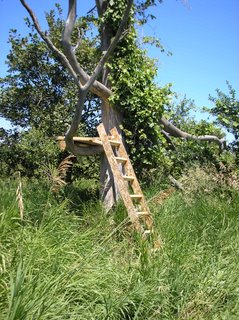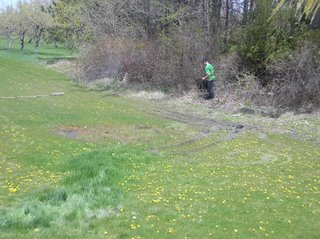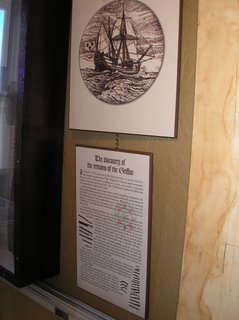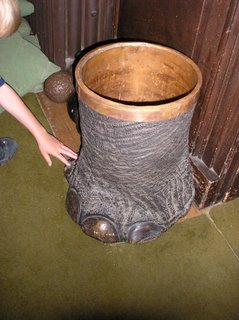Enjoy!









.jpg)









Bordering the rear of our property, a large portion of the farm crops are currently planted with soybeans. A short walk from our property boundaries sits a gentle flowing and shallow little creek with small fish swimming about it's running waters, one I haven't personally strolled out to explore just yet, though hubby has. It was always so muddy beyond our section of land when the idea crossed my mind, so soon, now with the field crop growth beginning to keep the grounds drier, I'll wander over to the brambling brook someday, having already been given permission from the farmer to enter the fields to do so. The children think it's just grand, yet to me, their little jaunts usually are accompanied with wet oozing mud dropping off their boots and over pants, hands and even cherub cheeks! Some fun for an adult, but for a kid, it’s normal fun stuff not thought of as part of a negative to the event.
Here are a few pictures to leave you with an impression of life here for the children. When I mentioned they run crazy and wild all over the place here, and sleep comes with the head dropping immediately to the pillow accompanying great snoring concerts, I wasn't kidding you know. *smile*
After waking in the wee hours of the morning to take the pups out for their daily morning walk duties, I'll often find one, or all of the children way out back. No wonder! It's a fabulous dreamy sort of never-never kid land, where huge creativity and imagination are initiated by uncluttered cityite lifestyles and boisterous annoying noises! It’s a place where real play embarks into lifelong memories. I wonder how they choose what to do first though, just where oh where… to begin.
Our first stop is the long awaited dream of building a tree fort for the older son here. The first thing he accesssed when entering this property for a possible purchase last December, was a tree, any kind of tree, to see his ever eager determination and vision of building and owning his very own tree fort, (like Nicholas and he constructed on his property), could come true for himself here. That specific ideal request was very important to him. On this land, hubby suggested the near dead one (smile) to erect a home away from home in. Oldest son was given a copy of “How to build tree houses, huts and forts by; David Stiles. for his birthday and has it memorized.
While construction was beginning on our barn, small leftover plywood pieces and bent nails were set aside by the subtrades to use some other time, or take away as a garbage lot once the building was finished. Little by little, I’d look out the window noticing, yet again, one child poking through the pile and sneakily bolting up the back to add it to their fort bootie pile (like pirates!) and they gladly accepted all bent nails, banging away to straighten them all up again. A bagful now rests out in the tree fort supply stocks. If you ask me the book must be providing fairly good how-tos, because these stairs look okay!
In these tall grasses, any imaginative play comes alive!
- I’ve seen hunting with swords or Lego guns. I've followed little headdress feathers bob up and down, with the walking gait of the native Indians, as they strolled along to their teepees deep in the forest.
- Scavenger hunts always award the seeker with new goodies to collect. (Two large toads came to the porch into bug bottles two weeks ago, added next to the antfarm filled with small ants...oh goodie!)
- Nature gardens have been constructed for little critters to visit during the midnight darkness nocturnal romps
You tell me. Is this not the perfect hideout for a young lad?
I found the perfect bell to hang outside and ring when seeking out the children for meals. My whistle as pitch perfect as it can get, isn't always heard, but this bell is!
Winding paths through the long grass
allow for imaginations to run wild
Caution; History of the ages at play!
Take two old swings from years gone by, one older teen who wants so badly to assist his younger siblings to have a swing set, and one very large Elm tree with an alcove surrounded with high grass to swing legs up into, back and forth with a tickle behind their knees, just above the grounds around the swing ground area, and here you have a lovely setting, in the shade of an old tree, one child or two usually swinging gently below, another (or two) hanging around above reading a book, finding a bug, looking for a bird’s nest, and you have a wonderful haven to mosey on to any time of day.
 Always out exploring.
Always out exploring.
You see, we have a little garden, and unbeknown to us when purchasing this house, the back pasture area we have now discovered, bursts with an abundance of gifts to satisfy any fresh fruit craving. We've been enjoying a marvelous strawberry patch, raspberry plants are almost to fruition, one blueberry plant looks quit healthy (yielding not much at this moment), then over the past few weeks, an abundance of white flowers has appeared, chamomile flowers to be exact.
I know, I know, how lovely they are right? Oh yes!
Simply gorgeous! Exquisitely appealing to the senses, I love to glance out the window to take a peak each day at them, then after a brief stroll outside, I also love to view them up close as well.
However, I was thinking about what in the world I will do with so many. Tea, yes, come for tea! I understand this type of plant is likened to an herb plant, growing out of control if not kept a decent width, cut and tended to. I'm thinking I'll bring some indoors and place them into a few lovely vases here. I'll be meticulous with good timing to cut a bunch for drying and adding to the tea stash, but then what?
What would you do with all these lovely fleurs??? Do tell!


Legendary French explorer Rene-Robert Cavalier, Sieur de LaSalle's flagship, the Griffon the first European vessel to sail the upper
Ever since the loss of LaSalle's Griffon in 1679, the
I found a very informative reference book on ship wrecks around the Great Lakes area, specifically Lake Erie, very well researched by a diving couple, one so full and thick on the shipwrecks deep inside Lake Erie alone, they were forced to split it into two volumes, with a third volume hot off the press very soon. These were titled "Erie wrecks, volumes 1 & 2" . I gave both volumes to Adam for a Christmas gift, mostly for the interesting aspect of them, but also to research and possibly visit someday, being a master diver himself. He loved them.
These vessels are time capsules of a kind that can be found nowhere on land. In addition to giving us a look into the society, technology, culture and artifacts of a bygone century, many of these vessels give an eerie picture of the horrific and desperate last moments of a ship and crew who knew they were likely to die. It is a startling realization that a short 150 to 200 feet under nearby waters lay many remarkable archeological resources which are largely undiscovered.
Recently one of our day trips took us to
Steve Libert, president of Great Lakes Exploration Group, LLC, has an obsession for exploration. National Geographic may have been credited for the phrase “Exploration is an Obsession”, but it was certainly inspired by someone like Libert. "Human progress depends on exploration and discovery,” he says. “And I think individual explorers still have an important role to play.” He himself has been researching “The Griffon” for over 28 years and is now suing the state of
The fact that the Griffon was built in the wilderness, as opposed to a shipyard, will reveal the circumstances


The Voyage of the Griffon
The Griffon’s maiden voyage started from
The Griffon sailed from what is known today as

Because the widespread availability of SCUBA is a relatively recent phenomenon, many historic and legendary vessels have yet to be discovered or disturbed. Most shallow wrecks that are easily accessible have already been damaged by waves and ice. Vessels deeper than 100 feet, however, are likely to be in excellent shape and are less likely to be found without an intensive search. Thus, many divers have taken up wreck hunting and new historical wrecks are being found every year. As sport divers become more comfortable in the 100 to 250 foot depth range, more and more discoveries will be made. The increasing availability of technology such as side scan sonar and the popularity of tech diving also insure that more wrecks will give up the secret of their locations.
The discovery of new wrecks is perhaps a positive and unavoidable eventuality. However, what happens to these wrecks is not. Experienced divers always relate stories of what a fantastic dive a wreck was "before she was stripped." In fact, just about every wreck that has been found in the Great Lakes has a collateral story of some artifacts that were stolen from it. Too often, naive divers are lured with stories of "treasure" to plunder wrecks. The hard truth is that most Great Lakes wrecks contain nothing even remotely resembling gold or silver. Divers find only "semi-precious" artifacts of an historical nature which they remove from the vessel and stick in the corner of their garage where no one else can view them. Wooden artifacts soon begin to rot no matter how much care is taken with them, as was the case with the 150 year old schooner Alvin Clark that was raised from Green Bay in 1969. She was destroyed after her metal parts cracked and she rotted into the ground. History has clearly shown the futility of removing artifacts from Great Lakes shipwrecks. Further, because the removal of artifacts from Great Lakes shipwrecks is illegal, most of these items are never seen again and rarely find their way to museums for proper conservation.
As the diving community in the Great Lakes has grown, many people have become staunch advocates of wreck conservation. The State of Michigan took a leading role when it established the Underwater Preserve system. These preserves ensure that wreck stripping and plundering will be kept to a minimum and that violaters will receive harsh penalties. Organizations such as Preserve Our Wrecks, Save Our Shipwrecks and others take an active role in conservation by regularly inspecting local wrecks to insure proper conservation. Other divers ensure conservation simply by letting their diving friends know that they will not dive with looters and even by reporting people who display artifacts to them.
There is also questionable validity in bringing artifacts to the surface for display in museums. Many nameboards have been taken off the sterns of wrecks and are now on the walls of museums and displays. Chadburns, binnacles, capstans, wheels, propellers and rudders have all been removed and placed in foreign environments where they look awkward and tell us little about their vessels. On land, these items often appear to be rusty and rotted pieces of junk. Aboard the ship however, these items have a great significance. They convey a greater sense of the vessel's historical nature and give clues as to its final moments and ultimate demise. Artifacts are also likely to last longer in the cold waters of the Great Lakes than anywhere else. There are already enough shipwreck artifacts in museums and displays to sate the appetite of the non-diving public. The artifacts of new shipwreck discoveries should be left in state for those interested enough to don a wetsuit.
Recently, the Alger Underwater Preserve sank an old harbor tug within its waters as a dive attraction. This tug which wouldn't have garnered a snapshot from even the most ardent marine historian now brings thousands of divers to Munising each year, generating hundreds of thousands of tourism dollars. However, on dry land one of the oldest and most historic wrecks on the Great Lakes, the Alvin Clark, couldn't even generate enough interest to keep her from the bulldozer. Clearly, these facts speak for themselves.
For these reasons divers in the Great Lakes region need to take action to further establish and maintain bottomland preserves and conservation organizations in all five Great Lakes and surrounding states and provinces. Perhaps by these means, there will still be some historical wrecks left worth diving in 50 years.



My mother and I are connoisseurs of historical homes and love to be participants of informational tours when possible. In the east, it’s very easy to get our fix, with the plethora of homes welcoming us to visit.
After some local shopping and lunch, we stopped at the tourist center in
Let me begin the next series of updated posts, by sharing our tour of “The Eldon House” with you.
Handmade grandfather clock brought with the Eldon
family from England in 1825
Grandson's wife from Holland had incredible wealth, and imported with her arrival, these original delft blue tiles from her homeland, as well as many other delft pieces around the home.
Part of the original library.
Need I mention to you how I liked this room?
Sitting by the fire, ladies visiting used the tapestry
shield to the left of the fireplace,
for protecting their faces from the heat,
and having their wax makeup melting. Funny!
Eldon House is the oldest house in
Built in 1834 for Captain John and Amelia Harris, the house remained in the Harris family until 1959 when it was given to the city complete with family furnishings and priceless treasures. Eldon House was the center of social life in early 19th century
Extremely pricey, red cedar imported from B.C. for ceilings
The wedding bed of the original couple,
as was with all original belongings.
One of the bedrooms for a daughter. The chair a the end of the bed was for kneeling down to say nightly prayers on.
Taking tea near the fireplace was necessary
to remain warm in the early mornings.
The Nursery, with all original toys left behind.
It reminded us of something out of Peter Pan.
During this age of elegance, wealthy homes were furnished with exquisite antiques and historic treasures from exotic places. Last year I visited the “Eastman House” in

Elephant leg umbrella stand
Rhinocerus wine decanter
Shields of crocodile, turtle, hides, and horns
and original gold gilted wallpaper from Japan.
With wealthy folks, life was made possible by domestic servants always on call in
Bells to summon the maid's services
The kitchen, renovated in the 1930's
The maid's staircase, well worn floorings.
There once was colorful linoleum here,
all worn down now as shown below.
 If you know me, you can imagine the pictures I took touring this home. I loved the fact, each and every piece in this home belonged to this family. What a huge heritage value it represents, of beloved treasures and collections, for folks like us to enjoy browsing through. There was a table in the men's cigar area (where the men excused themselves into later after dinner. The women had their own little area), binders filled with photos, addtional information, and one was filled with the biography bits of the servants who worked inside of this home, lived there, then moved on to have their own families over time. I wanted to sit most of the remaining time just to read, but the outside grounds still beckoned us outdoors. You must visit this house if you travel to the area someday!
If you know me, you can imagine the pictures I took touring this home. I loved the fact, each and every piece in this home belonged to this family. What a huge heritage value it represents, of beloved treasures and collections, for folks like us to enjoy browsing through. There was a table in the men's cigar area (where the men excused themselves into later after dinner. The women had their own little area), binders filled with photos, addtional information, and one was filled with the biography bits of the servants who worked inside of this home, lived there, then moved on to have their own families over time. I wanted to sit most of the remaining time just to read, but the outside grounds still beckoned us outdoors. You must visit this house if you travel to the area someday!
A few dozen original black and white sketchings,
each representing a Shakepeare play.
Many more were around the home.
Remember this family came from England
If you wish to check out the Eastman House in
After our visit to the Eldon house, we drove only a few blocks down the road to find these, and toured the museum as well. Many fine history books were in the gift shop as you could only imagine. *wink*
This used to be a Fort along the Thames River,
circa 1824/1825 Gothic Revival,
now fully restored and used as the Middlesex County Courthouse.
It's next door to the London Museum. Very cool looking!
More historical adventures to come.....be patient with me okay?

www.flickr.com
|
